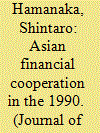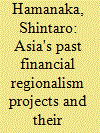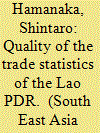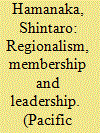|
|
|
Sort Order |
|
|
|
Items / Page
|
|
|
|
|
|
|
| Srl | Item |
| 1 |
ID:
102759


|
|
|
| 2 |
ID:
105313


|
|
|
|
|
| Publication |
2011.
|
| Summary/Abstract |
This article analyzes five significant institutional variables related to membership and control of institutions, using comparative case studies of Asia's past regional financial projects from the 1950s through the 1990s. The five variables are: (i) countries included in or excluded from membership, (ii) membership tiers, (iii) institutional decision-making process, (iv) executive positions at organizational structure (e.g. secretariat and headquarters) of institutions, and (v) the location of the secretariat/headquarters. Past financial regionalism projects hold several important lessons for current initiatives. First, in the case of regional financial institutions, "inclusion in membership but exclusion from regional membership" is a possible option and it is crucial to go beyond the simple debate on the membership problem, namely inclusion and exclusion, when designing a regional financial institution. Second, no single country should dominate the decision-making process by voting power-an institution must maintain a delicate balance among its members in terms of voting. And finally, key to determining the success or failure of regional financial institutions is which country hosts the secretariat/headquarters and sends staff to the executive positions.
|
|
|
|
|
|
|
|
|
|
|
|
|
|
|
|
| 3 |
ID:
111472


|
|
|
|
|
| Publication |
2011.
|
| Summary/Abstract |
This paper assesses the quality of the trade statistics of the Lao People's Democratic Republic (Lao PDR) by comparing its export/import data with the import/export data of its trading partners (mirror data). The author finds, first, that publicly available Lao PDR statistics compiled by the Ministry of Industry and Commerce (MIC) are not consistent with the Harmonized System (HS) of classification. It would therefore be advisable for the Lao PDR to release the HS classification-based data. Second, there is concern about the quality of the import data. For example, total imports from major trading partners are less than half of the total of those partners' recorded exports to the Lao PDR. Lao PDR imports of fuel and gas, vehicles and parts, plus construction materials, do not seem to be correctly reflected in the statistics. The government's policy of controlling domestic prices, irrespective of international prices, seems to produce incentives for import smuggling. Third, the overall quality of the Lao PDR's export data is good compared with its import data. Most of the differences between the respective statistics of the Lao PDR and its trading partners are connected with mineral-related and wood-related products. However, export restrictions on raw logs, for example, which aim to support domestic wood processing industries, seem to produce incentives for export smuggling. The unsatisfactory quality of the trade statistics, especially with regard to imports, has important policy implications. First, there is a large loss in tariff revenue. Second, while annual Lao PDR trade deficits appear to be small or moderate if calculated using MIC statistics, the actual deficits are likely to be far larger.
|
|
|
|
|
|
|
|
|
|
|
|
|
|
|
|
| 4 |
ID:
192173


|
|
|
|
|
| Summary/Abstract |
Drawing inspiration from a Chinese proberb, this paper offers an alternative interpretation of regionalism, with a special reference to its membership. This alternative interpretation provides insights into the exclusionary aspect of regionalism, for which mainstream international relations theories lack a certain efficacy in providing plausible explanations. We hypothesize that a state forms a regional group in which it can be a leader, excluding states that are more powerful than it is. A state values the leading position in a regional group, even in a small regional group. To test the hypothesis, this paper investigates regionalism launched in Asia during the second half of 20th century, with special attention to the inclusion and exclusion of the US. By analyzing diplomatic records obtained at four national archives (Australia, Japan, the UK, and the US), as well as memoirs by retired officials and other studies, this paper shows that regionalism in Asia was often pursued in an exclusionary manner, mainly by Japan, and to a lesser degree by Indonesia. The paper also discusses whether and how regionalism in Europe can be explained with this alternative theory.
|
|
|
|
|
|
|
|
|
|
|
|
|
|
|
|
|
|
|
|
|